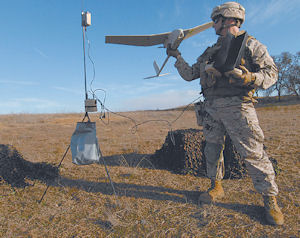Before the Wasp gets used in the battlefields of Afghanistan, the small, lightweight aircraft gets a workout above the fruit fields of Ventura County. Piloted from the ground by a controller similar to one used for video games, the Wasp floats gently and silently on the air, banking this way and that by the battery-powered propeller before coming in for a landing on the dirt of a pumpkin patch. Though small in size – the Wasp weighs all of 1 pound – the pilotless aircraft and others designed and manufactured by Aerovironment in Simi Valley mean big business. While unmanned aircraft, or drones, are nothing new for the military, the unconventional warfare being fought in Iraq and Afghanistan has speeded up development of more sophisticated air vehicles. Those developments, in turn, have been good for manufacturers like Aerovironment and AirStar International, and for suppliers scattered throughout Los Angeles and Ventura counties. And in the empty airspace above the Antelope Valley can be seen the multi-million dollar Global Hawk from Northrop Grumman Corp. and the Predator, made by General Atomics Aeronautical Systems Inc. As unmanned aerial vehicles (UAVs) can save lives on a battlefield, the military market will grow while other new markets, like law enforcement and media and entertainment, will be added or expanded. “We had no idea what we were getting into,” said Jacob Inbar, president, chief executive and co-founder of microassemblies manufacturer AML Communications in Camarillo. “But our technology was suited for what was needed.” AML started supplying for the UAV market about five years ago when it just started to take off. As a producer of components that are small and light, they were just what were needed to put into the aircraft. Last month, AML received a $3.7 million contract to supply parts for a first tier defense contractor to supply assemblies over a 12-month period. UDASH Inc. in Simi Valley is waiting on its first production contracts but did sheet metal fabrication work for drone prototypes for a two-year period starting in 2006. The company looks to make bids on UAV projects this year, said owner and founder George Melamed. “Once our name goes on the books for production it will be there on a continuous basis if the government allows the project to go on,” Melamed said. Strategic needs Aerovironment has been designing and building unmanned aircraft for just slightly longer than those other companies, starting with Dragon Eye in 2003 and moving on to the Raven, Puma and Wasp. The company, which went public in 2007, was built on a strategy of understanding the strategic needs of its clients. Each aircraft is launched by hand, easily assembled and repaired and simple to learn how to fly with the controller. All are designed to be taken with troops operating away from base and sent up for reconnaissance. The Raven, the company’s best selling aircraft, is carried in a rucksack, while the newest model under development, the Switchblade, is small enough to carry in a tube and be fired from a mortar. “This is a squad level asset,” said Steve Gitlin, the company’s vice president for marketing strategy. “One guy can carry and operate this system.” Aerovironment went through a lengthy R&D phase before going into production with its aircraft. Sales of the Raven and its other models account for 90 percent of the company’s revenues with the remainder brought in by charging stations for electric vehicles. Four classes Unmanned aircraft come in four classes, from the very small such as the Wasp that cost thousands of dollars to the extremely large, costing millions. Aerovironment has staked out its space at the two extremes – the Global Observer has a 175-foot wingspan – while AML serves the middle market of aircraft in the six to 10-foot long range. AirStar International in Moorpark, a subsidiary of aerospace firm The Mundus Group, also works on the smaller aircraft market, specifically with radio-controlled helicopters equipped with cameras. AirStar recently received an order for one of its reconnaissance copters from the U.S. Marine Corps for use in Afghanistan. The aircraft has to be redesigned to meet military specifications. AirStar camera copters have also been used by film companies and the media and in July offered one to CNN to get aerial views of the oil spill in the Gulf of Mexico. Attempts to reach a representative of AirStar International were not successful.
